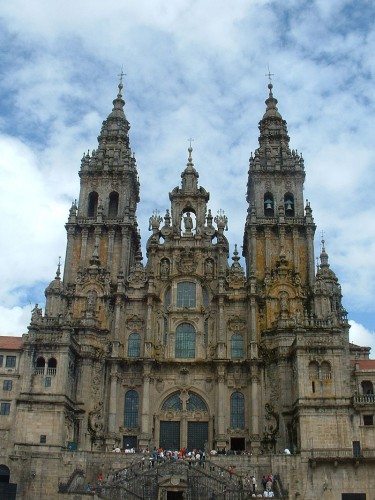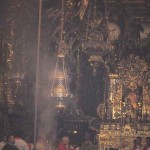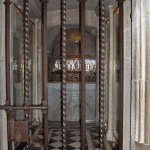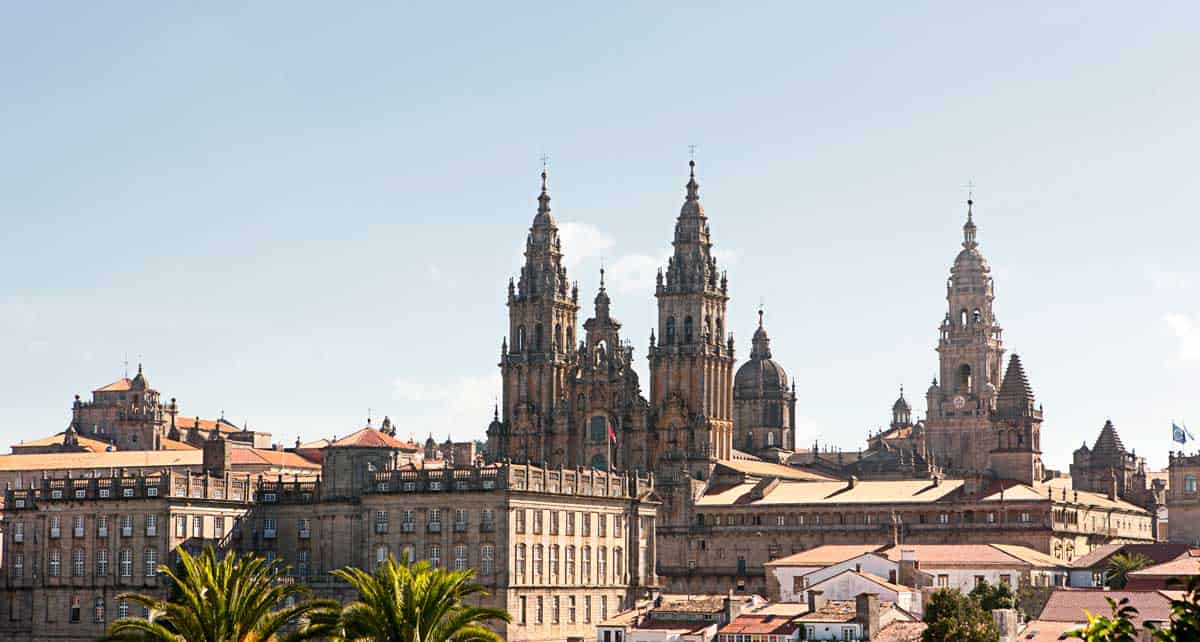For most pilgrims undertaking the Camino de Santiago, the end of the journey is Santiago de Compostela Cathedral. The cathedral lies at the heart of old Santiago – indeed, it forms the center around which the medieval city took shape and grew into its present form.
As the sacred monument housing, the earthly remains of St James the Greater, the bringer of Christianity to Spain, its structure and embellishments express centuries of Christian faith, piety, and veneration.
The Cathedral of Compostela Today
As pilgrims enter the outskirts of Compostela, they can see the Baroque spires of the Obradoiro or west façade; this façade has come to symbolize Compostela, the Camino, and modern Spain (it figures on the Spanish minting of Euros). There are 
As a pilgrimage foundation, the Cathedral of Santiago de Compostela allows pilgrims to walk around the interior along extended aisles, paying homage in chapels and before a variety of images while Mass is being conducted in the central nave. A Pilgrim’s Mass is said every day, during which the immense botafumeiro or incense burner swings its smoky way across the transepts. Dominating the attention of pilgrims is the high altar, located above the crypt where the relics of the saint are located. The altar is a Baroque wonder, glittering with gold; above it hovers a statue of Saint James, which can be embraced by pilgrims through a special opening in the back of the altar. Chapels radiating out behind the altar contain art that represents centuries of pious donations and that forms a veritable museum of paintings and sculpture.
Perhaps the most striking art treasure in the cathedral’s interior is the Portico da Gloria, the narthex or porch of the western façade (pilgrims from the Camino Frances usually enter the cathedral through the north façade, so the Portico da Gloria may in fact form their exit point). This treasure of medieval sculpture deserves a day’s visit in itself. It consists of three doorways opening into the central portion of the cathedral; the area above the doorways and the piers that separate them are encrusted with extraordinary sacred images. Christ sits in majesty above the central doorway, surrounded by the Evangelists with angels. Apostles and Old Testament prophets stand in attendance, while the central pier is devoted to the welcoming figure of Saint James himself; his foot is worn where centuries of pilgrims have stroked the stone in respect and relief. Heaven, Purgatory, and Hell, with their angels and demons, make up the background. The Portico da Gloria forms a kind of visual summation of Christian doctrine.
History of the Cathedral
When the sarcophagus of Saint James was discovered miraculously in the early 9th century, a small sanctuary was built to protect the relics; this soon became a center for pilgrimage. This original church was violently destroyed in 997. The building that would become today’s cathedral was begun at the end of the eleventh century to serve the growing numbers of pilgrims. The Cathedral of Compostela was originally designed in the Romanesque fashion; if seen from above, it would appear to be a gigantic cross, the central “plank” of which is the nave and the cross-arm the transept. This basic Romanesque structure can be seen most clearly in the interior; around it have accrued chapels and other sacred structures. Finished in 1211, the Cathedral dominated the city of Compostela, which had now become an archbishopric, with Rome and Jerusalem one of the most powerful in Christendom.
The building that would become today’s cathedral was begun at the end of the eleventh century to serve the growing numbers of pilgrims. The Cathedral of Compostela was originally designed in the Romanesque fashion; if seen from above, it would appear to be a gigantic cross, the central “plank” of which is the nave and the cross-arm the transept. This basic Romanesque structure can be seen most clearly in the interior; around it have accrued chapels and other sacred structures. Finished in 1211, the Cathedral dominated the city of Compostela, which had now become an archbishopric, with Rome and Jerusalem one of the most powerful in Christendom.
During the Renaissance, the University of Santiago de Compostela was formed, occupying the former Pilgrim’s Hospital next to the cathedral itself (the University of Santiago is still going strong, but has expanded far beyond the Renaissance location). The modern cathedral underwent major additions and expansions in the seventeenth and eighteenth centuries, in ornate Baroque and Neoclassical styles that make the new elements easy to distinguish from the earlier construction. The Azibecheria façade, for example, finished in 1769, contains both Baroque and Neoclassical sections, while the east façade (da Quintana) dates to a century earlier. Some portions of the cathedral, like the Clock Tower, were worked on at intervals over a number of centuries; the clocks in place now were only installed in 1990!
Roman Compostela
The archaeology of the site of the Cathedral of Santiago de Compostela is fascinating, opening up wide unexplored vistas of antiquity. During the late nineteenth and early twentieth centuries, scholars began excavating the area of the crypt of Saint James, which lies under the Baroque high altar. The work had to be undertaken with great care, but has unearthed quite amazing results. Visitors to the cathedral can take a special tour of the excavations, while some of the archaeologists’ finds are on display in the cathedral’s museum.
Archaeologists have revealed that the old city of Compostela was inhabited, starting probably about 50 AD and continuing until the beginning of the 5th century, by people who had adopted Roman material culture. In the area of the cathedral, Roman burials have been found that date from the 3rd century AD. The sepulchre said to contain Saint James’ relics was discovered in the 9th century in what seems to have been an overgrown and abandoned cemetery originally used by these people. It was this sepulchre around which the original church, destroyed in 997, was built. For a scholarly review of the history of the sepulchre and its excavations, see Jose Suarez Otero’s article at Academia.edu
Celtic Santiago de Compostela
Before the Romans conquered the Iberian peninsula, the area of Galicia, the province where Compostela is located, was inhabited by Celtic nations. Their presence is well documented and has given rise to much speculation about the role that Cape Finisterre, the spit of land jutting into the Atlantic Ocean and located 90 km from Compostela, played in the religious life of the Celts. Finisterre is the true end of the Camino de Santiago for many modern pilgrims. Facing the Atlantic Ocean with all of Europe behind, the place gives rise to thoughts of a passage out of this life into a more spiritual realm. The pilgrimage to Finisterre was certainly part of the medieval experience of Compostela, leading some scholars to suggest that this “Edge of the World” (the meaning of finis terrae in Latin) may have been a center of pre-Christian Celtic ritual.
Inside the Cathedral
The original church was consecrated in the presence of King Alfonso IX in 1211, additions were made over the years: the Baroque towers, ornate doorways, chapels, and altars – all combines to make Santiago Cathedral the most important monument to Spanish art in the middle ages.


Besides this main part, there are also a number of chapels of tremendous historic interest. There are from right to left: Chapel of El Pilar, began by Domingo de Andrade, containing the tomb of Archbishop Monroy in a setting of marble and jasper; the Mondragon Chapel, containing an altarpiece with pieta and a marvelous French grille work forged by Guillaume Bourse in the 16th century; the chapel of La Azucena, also known as the chapel of Dona Mencia, its founder whose tomb lies there adorned with handsome sculptures. This chapel comes just before the Porta Santa. Next, the chapel of El Salvador stands at the exact point where the building of the cathedral began.
Continuing the tour is the chapel of Nuestra Senora la Blanca with the tombs of the Espana family, and the strikingly baroque chapel of Saint John the Apostle. The chapel of San Bartolome still retains it Romanesque lines and is one of the most outstanding sculptural ensembles in Compostela. Next are the chapels of the Concepcion and the Espiritu Santo within which lie several Gothic and Renaissance tombs.
The Capela da Corticela, pre-Romanesque in origin, is one of the most interesting corners of the cathedral, its sumptuous décor includes The Adoration of the Magi a work by Maestro Mateo crowning the door. Past the Baroque altars of the chapels of San Andres and San Antonio is the chapel of Santa Catalina, a shrine to the Virgin of Lourdes. By its side is the tympanum of Clavijo, the antechamber of the neoclassical chapel of La Comunion, containing a fine sculpture of the Virgin del Perdon and the tombs of Lope de Mendoza and the prelate Bartolome Rajoy. Finally, the chapel of El Cristo de Burgos contains a copy of the famous Christ Crucified.
This is number one on my list of the best things to do in Santiago de Compostela.
Is there anything missing from this page? Is there any way it could be better? Let me know in the comments below. Thanks.

I love hiking, backpacking, and camping. From the Camino de Santiago to the West Highland Way in Scotland or simply a great day hike on the weekend. Hiking refreshes me, my mind, and keeps my body reasonably fit. So far I have walked three Camino routes and many other long distance hikes in the UK, Canada, and around the rest of Europe. One of the best was my hike up Ben Nevis.


Fabulous experience on two occasions walking the Camino de Santiago in 2017 & 2019. Attending the Pilgrim’s mass in Santiago was the ultimate experience finalizing my 800 km pilgrimage. To this day, watching the videos of the Mass gives me goose bumps .